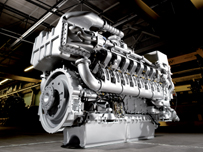Fitting the MTU power unit into the HSTs
15 Aug 2008
 MTU 4000 series engines are based on a common core developed in the drawing offices of MTU in Friedrichshafen in Germany. From the start it was designed as a multipurpose power generation unit. The core is the same but comes with different variants. There are, for example, versions with 8, 12, 16 or 20 cylinders with different turbocharger configurations or different manifolds.
MTU 4000 series engines are based on a common core developed in the drawing offices of MTU in Friedrichshafen in Germany. From the start it was designed as a multipurpose power generation unit. The core is the same but comes with different variants. There are, for example, versions with 8, 12, 16 or 20 cylinders with different turbocharger configurations or different manifolds.
The unit can be fitted into a naval frigate, a power generator, a fire pump, or even into a huge construction site dumper. It can also be fitted in a railway locomotive – a Class 43 HST for example – for this is what is now powering the First Great Western and NXEC fleets of HSTs. All the 30 year old Paxman engines have been replaced by MTU 4000 R41 engines - a 16 cylinder unit capable of generating 2720kw in certain marine applications.
The remit that MTU were given was to fit an engine that would provide the same power as the Paxman engine, but basically one that used less of everything, emitted less of everything and able to fit in the space available. The new power unit had to run at the same 1500 rpm speed because it was to be coupled with the original alternator.
In the end, there was a slight change in the footprint because the MTU engine is slightly wider and lower. The MTU is also a bit longer because it has sixteen cylinders as opposed to the Paxman’s twelve. The engine is slightly de-rated to match the power output. It doesn’t need to go any faster, it just has to match the acceleration. The same radiator has been plumbed in with very few changes - it is just a very simple system. The MTU unit rejects less heat to coolant, so that is why the existing system could be used.
Control systems
The power unit is truly 21st century, but it is coupled to ancillary equipment that believes that it is dealing with an engine over thirty years old. The driver’s controls have not been altered and link to a sophisticated generic control system to emulate the former Paxman engine. There is an interface control panel that talks to the controls that are already there.
Thirty year old commands have been translated into 21st century performance. MTU are very good at control systems, but nevertheless it needed a bit of careful attention to slow their system down to work with older technology and give what was expected. The special control programme that was written for the HST sits in a basic generic platform used with most of the MTU engines.
The well known scream of a Paxman powered HST comes from the turbo chargers, along with other general exhaust noise. Back in the 1980s, this seemed quite acceptable. Noise tolerance was different then. It was the age of Concorde – not quite a whispering jet! The new MTU engines have four turbochargers which are noticeably quieter. The exhaust is channelled through the existing silencer box, although some modifications were done at the manifold interface. The other potential source of noise, the fans, has not been altered.
Common rail fuel system
Fuel efficiency is achieved in part through the use of a different fuel system. The common rail system is used - an alternative to individual fuel injection. It’s a sort of fuel ’bus bar’ that delivers fuel at a common pressure allowing it to be drawn off giving a much quicker response and much better combustion.
In addition to the HST power unit there are well over 500 MTU engines fitted to the fleet of Turbostar units. These underbody engines – the 6R183TD13 – develop over 400hp.
